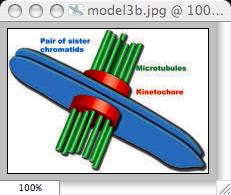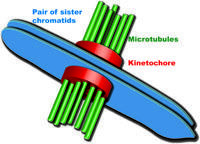Kinetochores-Microtubules-chromosomes
Cells divide throughout life to grow and renew tissues. During cell division, the genetic material (chromosomes) should be equally and accurately separated between the two daughter cells. Each human cell has 23 pairs of chromosomes. Errors in chromosome separation are often found in tumours.
My interest is to understand the mechanism by which chromosomes are captured by microtubules (imagine ropes capturing a bulky mass) and separated into two equal sets.
How do microtubules pull and push chromosomes during chromosome separation?
How is biochemical energy translated into mechanical movement of chromosomes?
These are the two fundamental and fascinating questions of my research work.
Background:
Microtubules (in green) capture chromosomes (in blue) in a stochastic manner via large multi-protein structures called ‘kinetochores’ (in red). Each human kinetochore attaches to 20-40 microtubules.
Microscopists had known for nearly 50 years that even a single incorrectly attached kinetochore is sufficient to pause the separation of all chromosomes within a cell. This way the cell makes sure that chromosomes do not permaturely separate before all of them are correctly attached to microtubules from opposite sides of the spindle. The molecular players essential for this pivotal error-check mechanism were revealed using yeast genetics. These are evolutionarily conserved 'checkpoint proteins' present in all cells from yeasts to humans. But the precise biochemical nature of the signal monitored by checkpoint proteins is not known. This is a puzzling and one of the hot questions in the field.
Another interesting question and my favourite one is the following: Since microtubule capture is stochastic, there must be error correcting mechanisms- i.e., to stablize correct attachments and to selectively lose wrong ones. Very few clues exist to describe this mysterious process as well.
To unravel how the proteins of the kinetochore signal incorrect attachment and coordinate mechanical movements, we first need to understand how the proteins of the kinetochore interact with microtubules.
I employ quantitative cell-biology assays to follow the dynamic movements of chromosomes during mitosis. I use molecular tools to analyse how the proteins of the kinetochore influence chromosome movement.
For more information on results, wait to see my paper or poster at ASCB :)

My interest is to understand the mechanism by which chromosomes are captured by microtubules (imagine ropes capturing a bulky mass) and separated into two equal sets.
How do microtubules pull and push chromosomes during chromosome separation?
How is biochemical energy translated into mechanical movement of chromosomes?
These are the two fundamental and fascinating questions of my research work.

Background:
Microtubules (in green) capture chromosomes (in blue) in a stochastic manner via large multi-protein structures called ‘kinetochores’ (in red). Each human kinetochore attaches to 20-40 microtubules.
Microscopists had known for nearly 50 years that even a single incorrectly attached kinetochore is sufficient to pause the separation of all chromosomes within a cell. This way the cell makes sure that chromosomes do not permaturely separate before all of them are correctly attached to microtubules from opposite sides of the spindle. The molecular players essential for this pivotal error-check mechanism were revealed using yeast genetics. These are evolutionarily conserved 'checkpoint proteins' present in all cells from yeasts to humans. But the precise biochemical nature of the signal monitored by checkpoint proteins is not known. This is a puzzling and one of the hot questions in the field.
Another interesting question and my favourite one is the following: Since microtubule capture is stochastic, there must be error correcting mechanisms- i.e., to stablize correct attachments and to selectively lose wrong ones. Very few clues exist to describe this mysterious process as well.
To unravel how the proteins of the kinetochore signal incorrect attachment and coordinate mechanical movements, we first need to understand how the proteins of the kinetochore interact with microtubules.
I employ quantitative cell-biology assays to follow the dynamic movements of chromosomes during mitosis. I use molecular tools to analyse how the proteins of the kinetochore influence chromosome movement.
For more information on results, wait to see my paper or poster at ASCB :)

